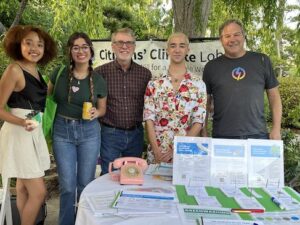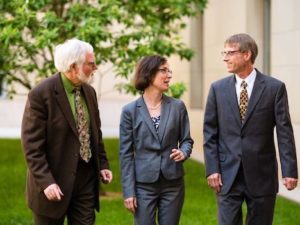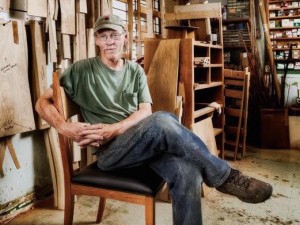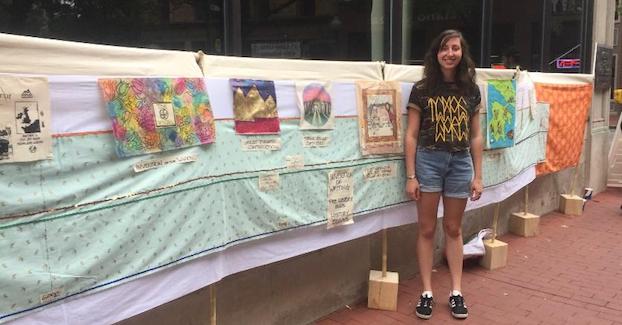
This Climate Art Banner, pictured here with local artist Kaleigh Phillips, is just one of the Charleston, W. Va. chapter’s creative outreach efforts.
Making outreach magic in Charleston, W. Va.
By Alex Amonette
Becky Park, who joined Citizens’ Climate Lobby in 2014, is the group leader for the Charleston, W. Va. chapter. I spoke with Becky about two hugely successful outreach efforts they’ve done recently: a film screening and panel, and a unique art project.
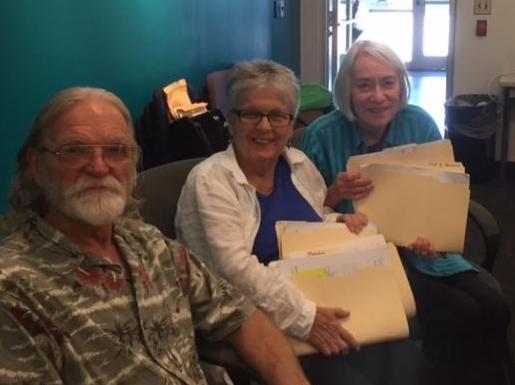
A few of the Charleston W. Va. CCL volunteers. Michael is a former coal miner; Pam is the chapter’s tabling chair; and Diane hosts the Saturday meetings. They’re holding letters to MoCs.
Their success stems from letting each volunteer really lean into their particular skill set, Becky explained. “Our volunteers have many different talents. We use those talents according to what people want to do. We have ‘people’ people, writers, and researchers. We have people who are amazing at engaging the public when we have information tables at events. Our tabling chair will tell you when she sits down to write a letter, she gets so mad she can’t write anymore! But she is a great tabling person.”
Another volunteer, Regan, works in a law office, plays in the symphony, and is involved with the W. Va. International Film Festival. “She is a major resource for our group—a good researcher and writer,” Becky said. “She was also instrumental in the last big event we had.”
More than 200 attend a climate film screening & panel
In July 2017, Becky and her chapter recognized that “An Inconvenient Sequel: Truth to Power” was coming out just as hurricane season was gaining steam. Since it was new and especially relevant, the chapter decided to host a screening. “We showed the film in a large commercial movie theater (a six-plex). Demand was so high, the theater manager put us in their largest theater,” Becky said. “We had 217 people buy tickets and attend.”
“Regan, being a musician, years ago had commissioned an arrangement of Jean Ritchie’s song, ‘Now is the Cool of the Day.’ The arranger is a very talented young man who has been recognized as a composer and gets a lot of local commissions. Regan had been looking for the right opportunity to premier this commissioned piece, and we agreed that this was it,” Becky explained. “She enlisted the state’s best quartet, plus a bass, and a powerful vocalist. Using music is a great way to get people focused and in a receptive frame of mind. It was drop dead gorgeous.”
Becky was the MC for the evening. To the audience, she said, “You’ve walked into a ‘revival’ of sorts with passionate people who want you to think deeply about our changing climate!” At the end of the film, the evening included three speakers, who spoke five minutes each.
The first speaker, Allan, an engineer and businessman, spoke about business opportunities, innovation, and the surge in renewable energy. The second was Jim, who spoke about CCL volunteer Jay Butera and his efforts that have led to the formation of the US House of Representatives’ bipartisan Climate Solutions Caucus and CCL’s work for a Carbon Fee and Dividend. The third, Ben, a local lawyer, spoke about the lawsuit led by Our Children’s Trust, which seeks to secure the legal right to a safe climate and healthy atmosphere for our present and future generations.
“The audience left on an upbeat note,” Becky said. “But just to seal the deal, we had high school students at the exits to collect their response cards, and each person received a ‘refrigerator card’ with info about our group meetings, the phone number for the Capitol switchboard, and two statements from the high school students. Both were good, but the shorter one said, ‘It’s like you’re digging your own grave… and digging ours, too.’ That still gives me chills.”
A powerful visual
“One of our volunteers, our scheduler Eleanor, is a quiet person but full of ideas. Eleanor suggested we make a striking visual,” showing Earth’s rising temperatures, Becky said. “Diane, one of our best volunteers, had arranged for a presentation at the library, and Allan, in response to a man who said, ‘Well, climate has changed before,’ unrolled a 15-foot long paper printout of ‘A Timeline of Earth’s Average Temperature.’” The timeline shows how the global average temperature has changed before, gradually, but shot up like a hockey stick graph over the last few decades.
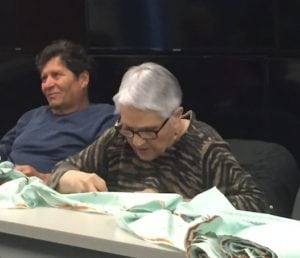

Diane, Rebecca and Linda stitching the orange sequins trim on by hand.
The banner’s bamboo frame makes it light and portable enough for one person to carry. “Bridget, Martha and myself were the main ‘project engineers.’ Hours and hours went into this creation, and the public response has been very gratifying!”
They also asked 13 artists to depict moments in history, adding even more visual interest to the banner. Newman Jackson created a piece called “Moses.” Charly Hamilton created a piece called “The domestication of dogs.” Kaleigh Phillips, a tattoo artist, created a piece titled “The last mammoth goes extinct on a tiny island in Siberia.” “What a hoot!” Becky said.
“We attached their art to the cloth banner and Jim, being a woodworker by trade, fashioned a bamboo framework. My friend Martha wrote a bunch of labels to provide meaning.” Becky added, “This is the only thing Martha does with us—she does not come to meetings or lobby but she was a great help creating our banner, and she has helped exhibit it many times.”
“We’ve used the Climate Art Banner to get people to write letters to our representatives in Congress. We stood with it downtown the other day for an hour and a half, and 58 people wrote letters to our representatives,” Becky said.
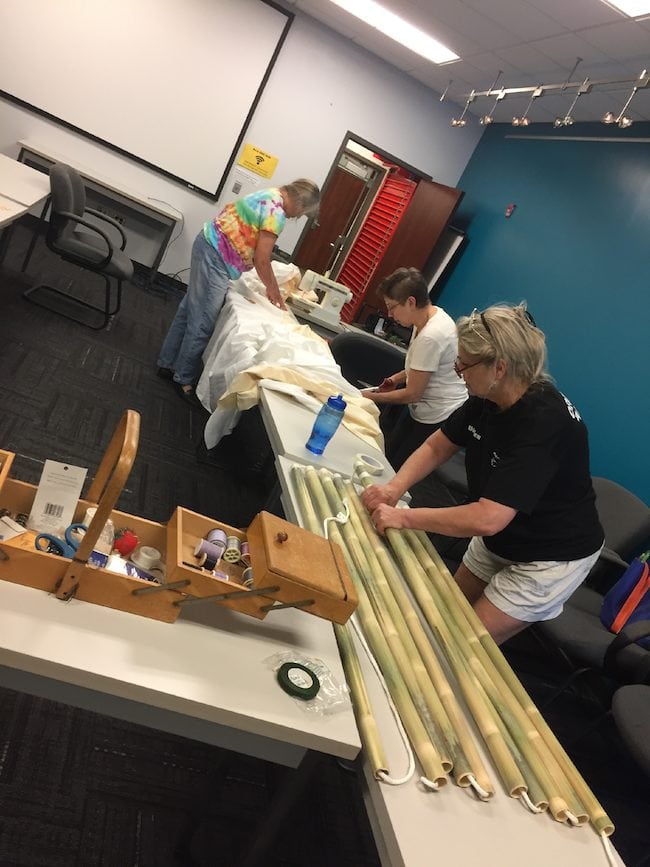
Bridget, Rebecca and Martha attaching the green fabric to the background muslin and readying the bamboo frame
“At one summer celebration downtown, Senator Joe Manchin and his wife Gayle walked by. Pam, our tabling chair, walked right up and said, ‘Come here, I want to show you something!’ and led them to the banner, where we walked them through the timeline and pointed out the hockey stick. Someone took a photo of Mrs. Manchin staring at the hockey stick with her mouth open!”
“The most remarkable thing is that it’s so easy to use the art to engage people,” Becky explained. And it’s clear that this art project not only engaged the community, but deeply engaged the chapter volunteers as well.
Connecting the dots, keeping hope
This outreach Becky and the Charleston, W. Va. group do is critical because they are in coal country, and the dots are not often connected between extreme weather events and climate change.
Becky said, “Last summer, we had a 1-in-1000 year rainfall event that caused massive flooding. 23 people died in the floods. Three towns were wiped out—Clendenin, White Sulphur Springs, and Richwood. I asked the mayor of Richwood if anyone talked about climate change and he said no, no one. We volunteered at a service center in Clendenin and we asked a lady there if anyone talked about climate change. Again, no. She said people don’t want to ‘offend’ each other. The very victims of these deadly floods don’t realize that due to global warming, warmer air holds more moisture, so when it rains, it’s like turning on a faucet.”
Thankfully, other active volunteers in West Virginia are helping connect the dots as well, such as Jim Probst, whose creativity and perseverance have resulted in four active chapters in the state. And of course, Becky is not giving up either.
“My hope is that as people wake up to the challenge of participatory democracy, it won’t be too late,” she says. “My hope is that people will demand that we spend our federal funds the right way and have the right federal policies to deal with our changing climate.” Until then, she says, “When you hit a roadblock, you just have to do what you can do.”
By empowering the members of her chapter and cheering them on as they put their individual talents to good use, Becky is doing what she can do—no doubt.
Author’s note: There are lots of websites, for example, Skeptical Science, that explain climate change. And the good news for people in West Virginia is that renewables are the fast growing jobs in the USA, proving there is a replacement for coal mining jobs.

